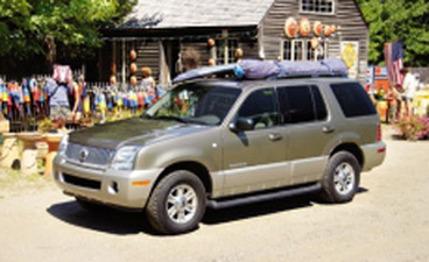 Long-Term Road Test
Long-Term Road Test
Before the Mountaineer arrived in 1996 as a '97 model, Mercury had zip on the SUV shelf. Executives there complained that not having one was costing the division customers on the showroom floor. So Ford relented and gave its neglected upmarket cousin an Explorer fitted with Mercury badges, a comblike chrome grille, and restyled bumpers. It was a sure thing, right? How were people to resist those alluring add-ons?
Somehow they did, and Mercury dealers saw their long-awaited Mountaineer sell at a snail's pace compared with the Explorer.
So when FoMoCo redesigned the Explorer and Mountaineer for 2002, it got more serious about differentiating the two. Instead of just rebadging an Explorer, Mercury designers actually did some work. The Mountaineer got a stylishly bold and machined look, compared with the Explorer's conservative and, by then, well-known appearance. Finally, the two looked different.
There were differences under the skin, too. Both received unique shock valving and tires, and the Mountaineer got sole use of a full-time all-wheel-drive system. And each received a different interior, with the Mercury's reflecting its futuristic exterior with lots of aluminumlike trim and white-face gauges.
Differences aside, there's no denying the vehicles' strong relationship - they still share chassis, powertrains, and just about every other major component. They also share major improvements over their predecessors, including a fully boxed frame, an independent rear suspension, three-row seating, rack-and-pinion steering, a new V-8 engine, and a five-speed automatic transmission.
So we acquired a Mountaineer in the summer of 2001 for a long-term test. The Mountaineer had everything an Explorer has, plus an all-wheel-drive system with no low range, an ideal feature to test during a Michigan winter. We liked the techno-styling, and we were curious to see if we'd still like it after 40,000 miles.
The base price of our all-wheel-drive Mountaineer ($31,210) was increased $695 with our choice of the optional 4.6-liter V-8 engine over the standard 4.0-liter V-6. The Luxury Group ($1685) added dual-zone automatic climate control, premium wheels, and a two-tone leather interior. The Convenience Group ($475) added a pair of lighted mirrors on the visors, a HomeLink system for opening the garage, and automatic headlights. To ease getting in and out, we opted for the running boards ($395), and to help us avoid unpleasant encounters with shopping carts, trees, and narcoleptic cows, we signed up for the reverse-sensing system ($255). Well, what the hell, we went all the way and added the towing package ($395), side-curtain airbags ($495), and a power sunroof ($800). An audiophile audio system ($690) rounded out the options. Our tab for the Mountaineer had ballooned to $37,095.
The truck arrived at our Ann Arbor offices in June 2001, and the logbook soon had plenty of positive remarks about the torquey all-aluminum V-8. Most felt power was more than adequate, offering enough juice for brisk highway travel and passing on mountain roads. When asked to tow a ton or more, the engine obliged without complaint.
The five-speed automatic, on the other hand, did not receive such glowing remarks. At 11,000 miles, tech editor Robinson complained of "a hammering jolt through the drivetrain when dropping out of overdrive." Others noted that upshifts were often abrupt and downshifts were rather lumpy when slowing to a stop.
The Mountaineer earned praise for its straight-line stability and firm but well-damped ride that most thought was "not too trucky." It's a big improvement over both the past live-axle Mountaineer and the slightly stiffer-legged Explorer. The fully independent suspension paid dividends, as did the rack-and-pinion steering, which was praised for its low effort and responsiveness.